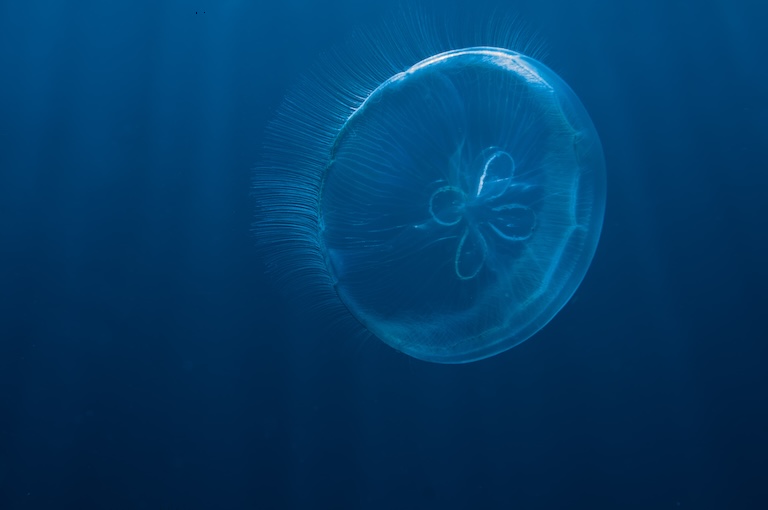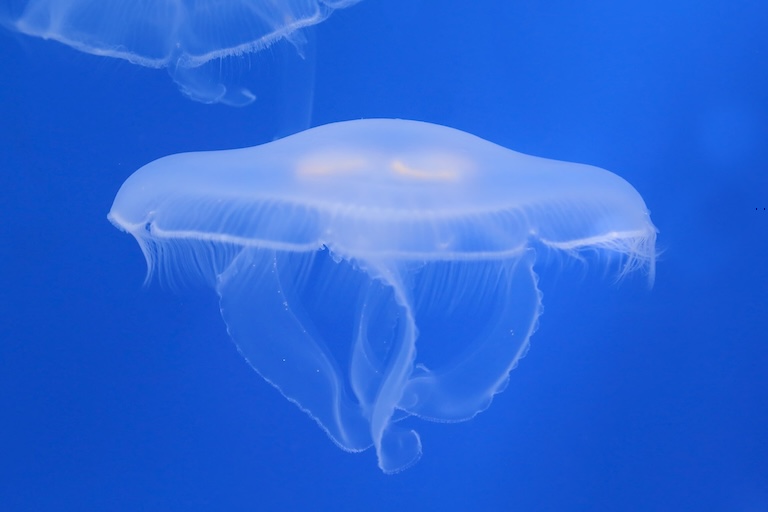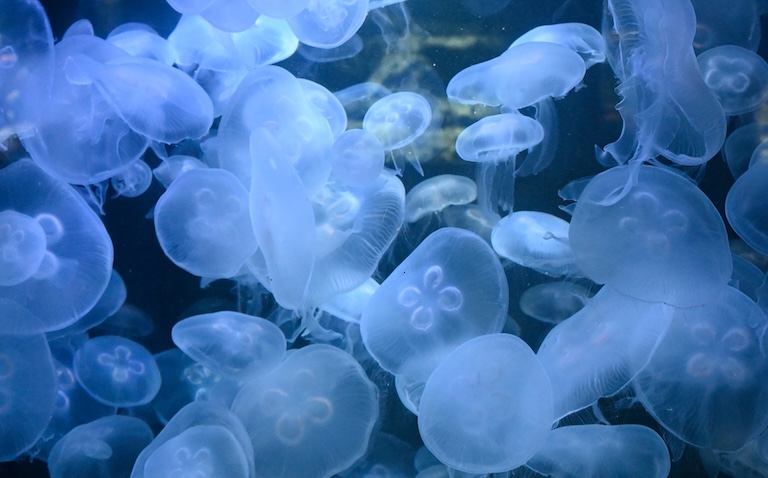Moon Jellyfish Profile
Jellyfish predate plants, and were even the dominant lifeform in the oceans for a fair few million years. They’ve been put on the back burner since the rise of, well, everything else, but the good news is that with our relentless decimation of all complex ocean life, they’re making a huge comeback!
At the forefront of this jelly revolution is one of the prettiest of them all: the moon jellyfish. This little soldier is leading the charge for the return of jelly dominance in our oceans.

Moon Jellyfish Facts Overview
| Habitat: | Oceanic, coastal waters |
| Location: | All oceans except the Arctic |
| Lifespan: | 25 years in captivity |
| Size: | Up to 35 cm across |
| Weight: | Not reported |
| Colour: | Translucent with blue veins |
| Diet: | Medusae, plankton, molluscs |
| Predators: | Turtles, sunfish, butterfish, other jellyfish |
| Top Speed: | Planktonic |
| No. of Species: | 1; 25 similar species in the genus |
| Conservation Status: | Not listed (IUCN) |
Moon jellies make up 25 known species in the Aurelia genus, with one, A. aurita, being the hard-to-identify rightful owner of the moon jellyfish common name.
Members of this genus look so similar they need to be differentiated with molecular analysis, so don’t worry too much about correctly identifying this one.
Moon jellies are elegant, transparent true jellyfish with electric blue veins and short tentacles. Their stings aren’t harmful to people but they are lethal to the zooplankton that sustains the species.
And thanks to the continued removal of everything else that eats zooplankton, these jellies are having a great time blooming all over the place.
Interesting Moon Jellyfish Facts
1. They’re Ulmarids
This is the family of true jellies that contains the “Big Red”, or Tiburonia granrojo; one of the largest sea jellies ever discovered. Moon jellies are smaller than this, though, ranging from 5–38 cm (2.0–15.0 in) across, and make up the genus Aurelia.
Technically, there’s only one species of moon jellyfish within this genus (A. aurita), but since they all look identical, they can only be identified in the lab.
2. You can tell them from their balls
One distinguishing feature of this genus is their horseshow-shaped gonads.
The body is made up of a pair of bells. The outer dome is transparent, and the inner one has a series of blue veins running through it. These veins are its reproductive organs, and they are perhaps the prettiest gonads in the animal kingdom.

3. They’re harmless
The whole animal is no more than 40cm across, and from the edge of its outer bell hangs a string of short tentacles. These are used to eat plankton and fish larvae that are unlucky enough to be stopped by the stings, but there are no long, dangly tentacles that are often seen in other species, just these hundreds of short ones.
And the sting itself is barely a nuisance to humans unless they are allergic or otherwise hper-sensitive.
4. They’re more or less planktonic
We often think of plankton as being tiny, even microscopic organisms that whales eat, and that’s partly true, but the definition of plankton includes anything of any size that doesn’t have control over where in the ocean it goes.
This means that as long as it can’t swim, it’s plankton, and in the case of the moon jellyfish, its lacklustre paddling skills probably categorise it as such. While it does have some semblance of controlled motion, this animal is almost entirely at the mercy of the currents.
That is, after they hatch.
5. Their eggs can swim
Sexually mature jellyfish mate and their fertilised eggs come equipped with swimming apparatus.
Jellyfish blur the lines in a bunch of ways, but swimming eggs really makes you wonder whether they can be called eggs at all. These unhatched jellies swim around for about 10 days, using special hairs, after which time they find and attach themselves to a hard surface.
At this stage they become fixed polyps and begin reproducing again, this time as clones of themselves, budding off from the polyp.
But the reproduction doesn’t stop there. The next stage also produces more pre-jellies, all of which drift about hoping to mature into new adults.
The final form, a medusa, goes through a pre-sexual stage before ending up as a sexually mature organism to restart the process. All of this can be accomplished in six months, and would normally be slowed down by predation, but human changes to the jelly’s environment are allowing them to bloom inconveniently. 1 2

6. They clog up the fishing industry
Trawling boats are a dystopian nightmare for the ocean, and consequently, anything that relies on the ocean to survive, like people.
In many areas they have not only indiscriminately killed most complex life forms but also functioned a lot like a cheese grater on the sea bed, shredding corals and accelerating the government-subsidised ecosystem collapse.
It’s the marine equivalent of fire-bombing the Amazon rainforest to hunt deer. Around half by weight of what’s caught in trawling is discarded as bycatch, and this is the majority of species brought up in nets targeting perhaps two types of fish.
And this devastation has removed various population controls for moon jellyfish, who are now left with all the zooplankton they can eat in the absence of larger predators. So, they bloom. And this is causing the humble trawlers a great deal of trouble.
As if in protest, millions of jellyfish are now clogging up the nets. Consequently, mass quantities of dead jellyfish are being dumped in the oceans as shipping discard, further increasing pollution in the waters. 3
7. They also affect power plants
The exact same mechanism is responsible for coastal blooms of moon jellies so vast that they’re now clogging up the cooling intakes for coastal power plants.
Jellyfish blooms like this are compounded by an excess of agricultural runoff from the land, fertilising coastal waters, and the general effects of ocean warming, which increases the range of the jellyfish, bringing them into new territories.
Further, while the sting of this jellyfish is mild, very few people want to jump in waters teeming with them, and so these blooms are affecting tourism.
With all this financial incentive to remove jellyfish, economists are scrambling to identify the fundamental aspects of ecology that would help eradicate the problem. Aspects like, for example, not removing all the jellyfish predators from the ocean.
It’s a radical idea, but desperate times call for desperate measures. 4
Moon Jellyfish Fact-File Summary
Scientific Classification
| Kingdom: | Animalia |
| Phylum: | Cnidaria |
| Class: | Scyphozoa |
| Order: | Semaeosteomeae |
| Family: | Ulmaridae |
| Genus: | Aurelia |
| Species: | Aurita |
Fact Sources & References
- Hamed A El-Serehy (2011), “Reproductive strategy of the jellyfish Aurelia aurita (Cnidaria Scyphomedusae) in the Suez Canal and its migration between the Red Sea and Mediterranean”, Research Gate.
- “Aurelia aurita Moon jellyfish”, Animal Diversity Web.
- Süleyman Özdemir (2014), “Preliminary study of a bycatch of pelagic trawl fishery in the southern black sea coast of Turkey: Moon jellyfish Aurelia Aurita”, Research Gate.
- Dong, Z. (2019), “Blooms of the Moon Jellyfish Aurelia: Causes, Consequences and Controls”, Sci Hub.
